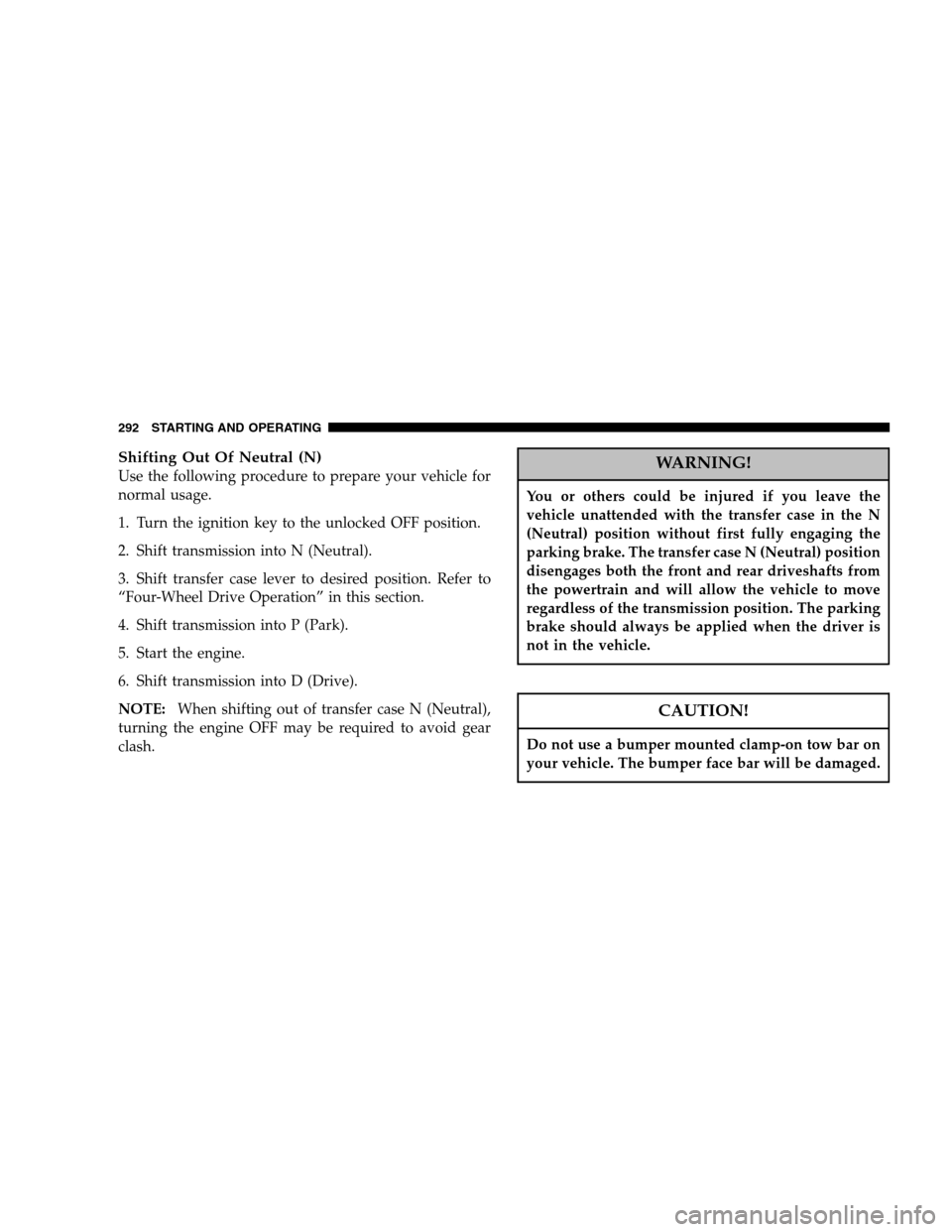Page 291 of 408

CAUTION!
It is necessary to follow these steps to be certain that
the transfer case is fully in N (Neutral) before
recreational towing to prevent damage to internal
parts.
1. Depress brake pedal.
2. Shift transmission into N (Neutral).
3. Shift transfer case lever into N (Neutral). Refer to
“Four-Wheel Drive Operation” in this section. Start en-
gine.
4. Shift transmission into D (Drive).
5. Release brake pedal and ensure that there is no vehicle
movement.6. Shut the engine OFF and place the ignition key into
the unlocked OFF position.
7. Shift transmission into P (Park).
8. Apply parking brake.
9. Attach vehicle to the tow vehicle with tow bar.
10. Release parking brake.
CAUTION!
Transmission damage may occur if the transmission
is shifted into P (Park) with the transfer case in N
(Neutral) and the engine running. With the transfer
case in N (Neutral) ensure that the engine is OFF
prior to shifting the transmission into P (Park) (refer
to steps7–8above).
STARTING AND OPERATING 291
5
Page 292 of 408

Shifting Out Of Neutral (N)
Use the following procedure to prepare your vehicle for
normal usage.
1. Turn the ignition key to the unlocked OFF position.
2. Shift transmission into N (Neutral).
3. Shift transfer case lever to desired position. Refer to
“Four-Wheel Drive Operation” in this section.
4. Shift transmission into P (Park).
5. Start the engine.
6. Shift transmission into D (Drive).
NOTE:When shifting out of transfer case N (Neutral),
turning the engine OFF may be required to avoid gear
clash.WARNING!
You or others could be injured if you leave the
vehicle unattended with the transfer case in the N
(Neutral) position without first fully engaging the
parking brake. The transfer case N (Neutral) position
disengages both the front and rear driveshafts from
the powertrain and will allow the vehicle to move
regardless of the transmission position. The parking
brake should always be applied when the driver is
not in the vehicle.
CAUTION!
Do not use a bumper mounted clamp-on tow bar on
your vehicle. The bumper face bar will be damaged.
292 STARTING AND OPERATING
Page 295 of 408
WHAT TO DO IN EMERGENCIES
CONTENTS
�Hazard Warning Flashers.................296
�If Your Engine Overheats.................297
�Jacking And Tire Changing................298
▫Jack Location........................298
▫Spare Tire Stowage....................299
▫Spare Tire Removal....................299
▫Preparations For Jacking................300▫Jacking Instructions....................300
�Jump Starting Procedure..................303
�Emergency Tow Hooks — If Equipped........305
�Towing A Disabled Vehicle................306
▫2WD Models Only....................306
▫4WD Models Only....................306
6
Page 297 of 408

IF YOUR ENGINE OVERHEATS
In any of the following situations, you can reduce the
potential for overheating by taking the appropriate ac-
tion.
•On the highways — Slow down.
•In city traffic — While stopped, put transmission in N
(Neutral), but do not increase engine idle speed.
NOTE:There are steps that you can take to slow down
an impending overheat condition. If your air conditioner
is on, turn it off. The air conditioning system adds heat to
the engine cooling system and turning off the A/C
removes this heat. You can also turn the Temperature
Control to maximum heat, the Mode Control to floor, and
the Fan Control to High. This allows the heater core to act
as a supplement to the radiator and aids in removing heat
from the engine cooling system.
CAUTION!
Driving with a hot cooling system could damage
your vehicle. If the temperature gauge reads “H”,
pull over and stop the vehicle. Idle the vehicle with
the air conditioner turned off until the pointer drops
back into the normal range. If the pointer remains on
the “H”, and you hear continuous chimes, turn the
engine off immediately, and call for service.
WHAT TO DO IN EMERGENCIES 297
6
Page 304 of 408

without letting the vehicles touch. Set the parking brake,
place the transmission in P (Park), and turn the ignition
to OFF for both vehicles.
3. Turn off the heater, radio and all unnecessary electrical
loads.
4. Connect one end of a jumper cable to the positive
terminal of the discharged battery. Connect the other end
of the same cable to the positive terminal of the booster
battery.
5. Connect the other cable, first to the negative terminal
of the booster battery and then connect the other end to
a non-paint metal surface on the engine of the vehicle
with the discharged battery. Make sure you have a good
contact on the engine.
6. Start the engine in the vehicle which has the booster
battery, let the engine idle a few minutes, then start the
engine in the vehicle with the discharged battery.7. When removing the jumper cables, reverse the above
sequence exactly. Be careful of the moving belts and fan.
NOTE:To start the vehicle following connection of a
booster battery, the Security Alarm System must first be
disabled by cycling a front door key cylinder or by using
the keyless entry transmitter.
WARNING!
Jump starting can be dangerous. To avoid personal
injury or damage to electrical components in vehicle,
observe the following warnings:
•Battery fluid is a corrosive acid solution and can burn
or even blind you. Don’t allow battery fluid to contact
your eyes, skin, or clothing. Don’t lean over a battery
304 WHAT TO DO IN EMERGENCIES
Page 305 of 408

when attaching clamps. If acid splashes in eyes or on
skin, flush the area immediately with large amounts of
water.
•Do not use a booster battery or any other booster
source that has a greater than 12–volt system, i.e., do
not use a 24–volt power source.
•Never attempt to jump start a discharged battery that
is frozen, because it could rupture or explode during
jump starting.
•Be sure your vehicle is not touching the jump start
vehicle.
•Observe all Battery Warnings in Section 7 of this
manual, while jump starting your vehicle.
WARNING!
Do not attempt to push or tow your vehicle to get it
started. Unburned fuel could enter the catalytic
converter and, once the engine has started, ignite and
damage the converter and vehicle.
EMERGENCY TOW HOOKS — IF EQUIPPED
If your vehicle is equipped with tow hooks, there will be
one in the rear and two mounted on the front of the
vehicle. The rear hook will be located on the driver’s side
of the vehicle.
NOTE:For off-road recovery, it is recommended to use
both of the front tow hooks to minimize the risk of
damage to the vehicle.
WHAT TO DO IN EMERGENCIES 305
6
Page 307 of 408
MAINTAINING YOUR VEHICLE
CONTENTS
�3.7L Engine...........................310
�4.7L Engine...........................311
�5.7L Engine...........................312
�Onboard Diagnostic System — OBD II........313
▫Loose Fuel Filler Cap Message............313
�Emissions Inspection And Maintenance
Programs............................314
�Replacement Parts......................315
�Dealer Service.........................316�Maintenance Procedures..................316
▫Engine Oil..........................316
▫Drive Belts - Check Condition And Tension . . . 320
▫Spark Plugs.........................321
▫Catalytic Converter....................321
▫Ignition Cables.......................323
▫Crankcase Emission Control System........323
▫Fuel Filter..........................323
▫Air Cleaner Filter.....................323
7
Page 309 of 408
▫Rear Tail, Stop, Turn Signal, And Back-Up
Lights.............................355
▫Center High Mounted Stop Light (CHMSL) . . . 356
�Fluid Capacities........................357�Recommended Fluids, Lubricants And Genuine
Parts................................358
▫Engine.............................358
▫Chassis............................359
MAINTAINING YOUR VEHICLE 309
7